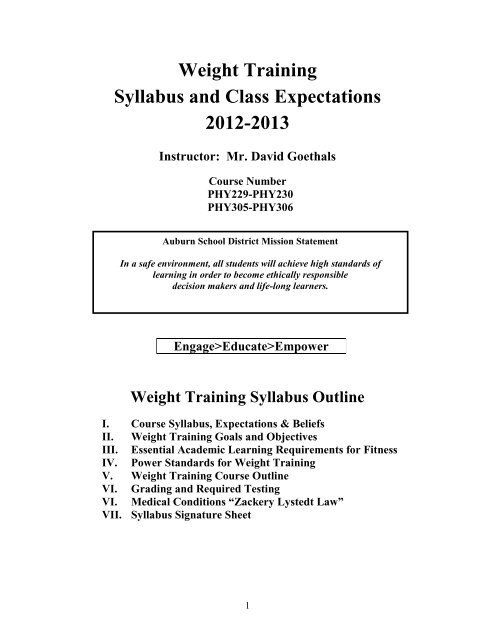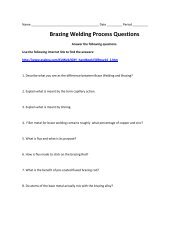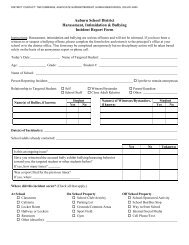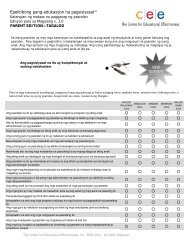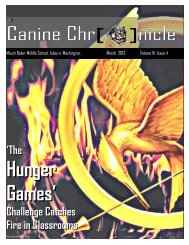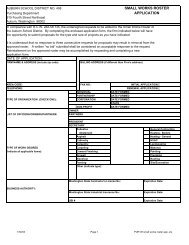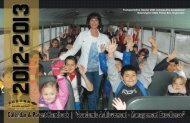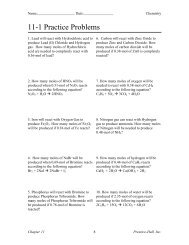Beginning Weight Training Syllabus - Auburn School District
Beginning Weight Training Syllabus - Auburn School District
Beginning Weight Training Syllabus - Auburn School District
Create successful ePaper yourself
Turn your PDF publications into a flip-book with our unique Google optimized e-Paper software.
<strong>Weight</strong> <strong>Training</strong><br />
<strong>Syllabus</strong> and Class Expectations<br />
2012-2013<br />
Instructor: Mr. David Goethals<br />
Course Number<br />
PHY229-PHY230<br />
PHY305-PHY306<br />
<strong>Auburn</strong> <strong>School</strong> <strong>District</strong> Mission Statement<br />
In a safe environment, all students will achieve high standards of<br />
learning in order to become ethically responsible<br />
decision makers and life-long learners.<br />
Engage>Educate>Empower<br />
<strong>Weight</strong> <strong>Training</strong> <strong>Syllabus</strong> Outline<br />
I. Course <strong>Syllabus</strong>, Expectations & Beliefs<br />
II. <strong>Weight</strong> <strong>Training</strong> Goals and Objectives<br />
III. Essential Academic Learning Requirements for Fitness<br />
IV. Power Standards for <strong>Weight</strong> <strong>Training</strong><br />
V. <strong>Weight</strong> <strong>Training</strong> Course Outline<br />
VI. Grading and Required Testing<br />
VI. Medical Conditions “Zackery Lystedt Law”<br />
VII. <strong>Syllabus</strong> Signature Sheet<br />
1
<strong>Weight</strong> <strong>Training</strong><br />
Course <strong>Syllabus</strong>, Expectations & Beliefs<br />
<strong>Auburn</strong> <strong>School</strong> <strong>District</strong> Beliefs<br />
The district improvement plan establishes belief statements that declare the<br />
commitment of <strong>Auburn</strong> stakeholders to improve learning for each student and to<br />
narrow the achievement gaps within the district. The beliefs developed by the<br />
improvement committee parallel the principles embedded in the Nine Characteristics of<br />
High Performing <strong>School</strong>s.<br />
Respect – Responsible - Relationship<br />
Where personalized learning reaches every R.A.V.E.N.<br />
R=Respectful, contributing citizens<br />
A= Accountable to themselves and to others<br />
V= Valued critical thinkers<br />
E= Effective at communicating<br />
N= Navigators of life’s challenges and opportunities<br />
<strong>Auburn</strong> <strong>School</strong> <strong>District</strong> Beliefs<br />
The district improvement plan establishes belief statements that declare the<br />
commitment of <strong>Auburn</strong> stakeholders to improve learning for each student and to<br />
narrow the achievement gaps within the district. The beliefs developed by the<br />
improvement committee parallel the principles embedded in the Nine Characteristics of<br />
High Performing <strong>School</strong>s.<br />
I. <strong>Weight</strong> <strong>Training</strong>s Team Philosophy<br />
We believe in mutual respect between all people. (Respect All!)<br />
We believe in student accountability.<br />
We believe in high expectations and a high level of success.<br />
We believe in working together to achieve a common goal: teamwork.<br />
We believe in a Drug Free classroom.<br />
We believe in open lines of communication, trust and honesty.<br />
We believe that ATTITUDE is everything!<br />
We believe that student will take personal responsibility for their actions.<br />
We believe that student will take responsibility to attend school every day.<br />
2
Behavioral Expectations<br />
The Students will:<br />
treat the teacher with respect<br />
give their best effort<br />
participate<br />
have a positive attitude<br />
ask questions<br />
cooperate<br />
respect all students<br />
take personal responsibility<br />
be on time to class<br />
remain on task<br />
The Teacher will:<br />
treat students with respect<br />
provide support and encouragement<br />
explain clearly<br />
be patient<br />
support each student<br />
listen to students and help<br />
be honest<br />
encourage students<br />
provide well structured lessons<br />
provide clear boundaries<br />
Classroom Expectations<br />
Each student is expected to dress out in appropriate P.E. gear and be in class in their assigned roll<br />
location by within 5 minutes after the tardy bell has rung. Appropriate P.E. gear consists of<br />
shorts, shirt, socks and tennis shoes.<br />
Each student will sign-in on the roll sheet and start their flexibility exercises within 5 minutes of<br />
the tardy bell.<br />
Students need to notify instructor about physical ailments, injury or sickness before roll is taken<br />
before class starts.<br />
Each student will participate in all warm-up and stretching activities at the beginning of each<br />
class.<br />
Each student will participate in all pre and post physical testing unless arrangements have been<br />
made with the instructor.<br />
Each student will be responsible for his/her own weight training file folder. Files will be required<br />
to be brought to class each day.<br />
There will be days when we will be running on the track. Please bring the appropriate clothing in<br />
case of rain.<br />
All students will treat others in this class with respect at all times.<br />
All safety rules and regulations will be followed without exception.<br />
All students are responsible for cleaning up and returning weights and equipment at their station<br />
to their proper location before being dismissed from the weight room.<br />
Each student is responsible for making up work missed for excused absences. Proper procedure<br />
to make up work is to provide the appropriate paperwork to show excused absence to instructor<br />
and ask for work and/or record sheets and assignments. It is the student’s responsibility to acquire<br />
any notes on lectures and/or conditioning information from other students. Worksheets may be<br />
obtained from the instructor. Students have one day for each excused absence to make up the<br />
missed work.<br />
3
II. <strong>Weight</strong> <strong>Training</strong> Goals and Objectives<br />
Goal: To develop a working knowledge of essential concepts, techniques, safety rules,<br />
practices and principles of weight training.<br />
Objectives:<br />
1. To provide each student the opportunity to master the basic techniques of weight<br />
training of large muscle groups with proper balance, spotting, breathing, lifting and<br />
safety techniques. Each student will perform for the instructor proper techniques of<br />
weight training lifts for squats, cleans, step-ups, bench and all machine, dumbbell and<br />
body weight exercises.<br />
2. Each student will participate in pre and post testing of the following: percentage of<br />
body fat; body weight to weight lifted ratio for bench, squat, cleans, hamstring and<br />
quads; VO2 (volume of Oxygen); muscle balance workout; conditioning evaluation<br />
exam; heart recovery workout; oxidative exam; vertical jump; flexibility; tonnage<br />
tests.<br />
3. Each student will outline the weight room and label each machine and rack with the<br />
correct name and major muscle or muscle group the machine works.<br />
4. Each student will outline and discuss the correct method of adjusting weights for<br />
Heavy (ATP), medium (LAO2) and light (O2) workouts by matching the correct RM<br />
(repetitions max) percentage with the correct set, repetitions, weight, percentage RM,<br />
and rest.<br />
5. Each student will complete all ten pre-post test worksheets and list improvements and<br />
discuss the percentage and benefits of the improvements for each physical test.<br />
6. Each student will display respect and encouragement for all participants and the<br />
instructor while developing a sound work ethic and completing each workout in a<br />
safe and positive nurturing environment.<br />
7. Each student will list, define and discuss the overload principle on the final exam.<br />
8. Each student will discuss the Essential Academic Learning Requirements in<br />
Fitness.<br />
9. Each student is required to wear <strong>Auburn</strong> <strong>School</strong> <strong>District</strong> #408 physical education<br />
uniform in each <strong>Auburn</strong> Riverside High <strong>School</strong> physical education class. Proper<br />
<strong>Auburn</strong> Riverside uniform includes the official ARHS shirts, shorts, socks, tennis<br />
shoes and appropriate undergarments. The uniform shirt will have the last name<br />
printed in black ink on the front in the block provided. Shirts and shorts are purchased<br />
thought the cashers office.<br />
10. Each student will complete the weekly weight training packet and record all scores in their<br />
weight training folder. Students are responsible for all recorded information in the file folder.<br />
11. Students will have a working knowledge of Physical Education class room based assessments<br />
(CBA’s). Each student will complete the CBA’s for weight training including all<br />
assignments, tests, activities, evaluation and goal setting worksheets.<br />
4
III. Essential Academic Learning Requirements<br />
for Health and Fitness:<br />
An understanding of good health and fitness concepts and practices is essential for all<br />
students. Businesses have already begun to realize the extent to which poor health practices can<br />
undermine an employee’s effectiveness and ability to succeed. The same is true of students.<br />
Teaching students good health and safety principles can lead to a lifetime of healthy practices,<br />
resulting in more productive, active and successful lives. The Essential Academic Learning<br />
Requirements in health and fitness establish the concepts and skills necessary for safe and healthy<br />
living, and in turn, for successful living. The following objectives are incorporated in this <strong>Weight</strong><br />
<strong>Training</strong> course.<br />
Objective 1. The student acquires the knowledge and skills necessary<br />
to maintain an active life: movement, physical fitness, and nutrition. To<br />
meet this standard, the student will:<br />
1.1 Develop the fundamental physical skills and progress to complex movement<br />
activities as physically able.<br />
1.2 Incorporate rules and safety procedures into physical activities.<br />
1.3 Understand the concepts of physical fitness and develop and monitor<br />
progress on physical fitness goals.<br />
1.4 Understand nutrition and food nutrients and how they affect physical<br />
performance and the body.<br />
Objective 2. The student acquires the knowledge and skills necessary to maintain<br />
a healthy life; recognize patterns of growth and development, reduce health risks, and<br />
live safely. To meet this standard, the student will:<br />
2.1 Recognize patterns of growth and development; develop an<br />
understanding of how various parts, organs and systems of the human<br />
body work together and how heredity and environmental factors may influence<br />
growth and development; understand changes that accompany maturity and the<br />
transition from adolescence to adulthood.<br />
2.2 Understand the transmission and control of communicable and<br />
non-communicable diseases.<br />
2.3 Acquire skills to live safely; anticipate risky situations and demonstrate<br />
skills to promote safety and to assist in emergency situations at school, at<br />
home, and in the community; evaluate strategies and develop a plan to manage stress<br />
constructively and lawfully; identify situations and decisions related to drug use.<br />
Objective 3. The student analyzes and evaluates the impact of real-life influences<br />
on health. To meet this standard, the student will:<br />
3.1 Understand how environmental factors affect one’s health.<br />
3.2 Gather and analyze health information; make informed choices<br />
about health services and products.<br />
3.3 Use social skills to protect health and safety in a variety of situations.<br />
3.4 Understand how emotions influence decision making; develop<br />
strategies to avoid or minimize risky situations.<br />
Objective 4. The student effectively analyzes health and safety information to<br />
develop health and fitness plans based on life goals. To meet this standard, the student<br />
will:<br />
4.1 Assess needs and resources<br />
4.2 Develop a health and fitness plan and a monitoring system that is<br />
consistent with life goals for work and leisure.<br />
5
IV. National Standards for Physical Education<br />
Standard 1: Demonstrates competency in motor skills and movement patterns needed to<br />
perform a variety of physical activities. “I can move correctly.”<br />
1.1 Develop movement and conditioning concepts as developmentally appropriate.<br />
1.1.1 Evaluates complex motor skills and movement concepts to activities to enhance a<br />
physically active life.<br />
1.2 Demonstrates and applies complex motor skills and movement concepts to weight<br />
training and conditioning.<br />
Standard 2: demonstrates understanding of movement concept, principles, strategies, and<br />
tactics as they apply to the learning and performance and physical activites. “I can train me<br />
and I can train others.”<br />
1.2 Demonstrates knowledge and skills to safely participate in activity.<br />
1.2.1 Analyzes and compares the risk levels and safety issues of exercises.<br />
1.2.2 Analyzes the importance of fitness in the work environment.<br />
1.2.3 Applies and demonstrates rules and safely while participating in physical activity.<br />
1.2.4 Integrates biomechanical principles and assesses performance.<br />
1.2.5 Understands and applies the components of skill related fitness.<br />
Standard 3: Participates regularly in physical activity. “I participate regularly.”<br />
1.3 Understand the component of health related fitness and interprets information from<br />
feedback, evaluation and self-assessment in order to improve performance.<br />
1.3.1 Evaluate, monitor and execute a personal fitness plan.<br />
Standard 4: Achieves and maintains a health enhancing level of physical fitness. “I am fit.”<br />
1.3 Understands assessment to evaluate and improve personal performance.<br />
1.3.1 Understand and implement FITT principle.<br />
1.3.2 Compare and monitor your progress according to fitness standards.<br />
1.3.3 Interprets information from feedback, evaluation and self –assessment in order to<br />
improve performance.<br />
1.4 Understands the components of skill-related fitness and interprets information from<br />
feedback, monitor and execute a personal fitness plan.<br />
1.4.1 Analyzes daily health and fitness habits.<br />
Standard 5: Exhibits responsible personal and social behavior that respects self and others<br />
in physical activity settings. “I can play fairly.”<br />
1.5.1 Evaluates the relationship of nutrition planning to physical performance and body<br />
composition.<br />
1.5.2 Evaluates how nutritional requirements change.<br />
Standard 6: Values physical activity for health, enjoyment, challenge, self-expression<br />
and/or social interaction. “I value PE, fitness and health.”<br />
1.2.2 Demonstrates appropriate modification to personal physical strategies, teamwork,<br />
and sportsmanship to engage all students.<br />
6
V. <strong>Weight</strong> <strong>Training</strong> Outline<br />
Weeks 1-8<br />
Weeks 9-14<br />
Hypertrophy and Basic <strong>Weight</strong> <strong>Training</strong> Program________________<br />
A. Introduction to weight training safety procedures<br />
B. Introduction to basic free weight lifts<br />
C. Development of safe lifting techniques<br />
D. Proper spotting techniques<br />
E. Mastery of correct breathing technique<br />
F. Introduction to circuit training<br />
G. Basic working knowledge of Wellness Model<br />
H. Participation in pre-testing<br />
I. Principles of weight training programs<br />
J. Basic working knowledge of three energy systems<br />
K. Working knowledge of muscle names<br />
L. Introduction to hypertrophy workout<br />
M. Mastery of the four physiological areas of a sound<br />
conditioning program<br />
Strength Cycle and Conditioning_______________________________<br />
A. Develop a working knowledge of periodization of weight training<br />
B. Develop a working knowledge of free weight lifting program with<br />
emphasis on safety, spotting, lift form and adjustments of sets, reps,<br />
%RM (rep max), and rest<br />
C. Master safe and proper lifting techniques for squat, bench and cleans<br />
Weeks 15-18 Power Cycle and High Intensity Interval <strong>Training</strong> (HIIT)___________<br />
A. Working knowledge of power phase of weight training<br />
periodization<br />
B. Participate in HIIT (High Intensity Interval <strong>Training</strong>)<br />
C. Basic knowledge of adjusting workouts from strength to<br />
Power<br />
Week 19<br />
Written and Physical Post-Testing______________________________<br />
A. Participation in post-testing<br />
B. 100,000/50,000 pound lifted Final Exam<br />
C. Assessment of personal strength and conditioning improvements<br />
D. Documentation of daily worksheets and weight training file folder<br />
E. Written documentation of all test scores recorded in student file folder<br />
7
VI. Grading and Testing Requirements<br />
Grades and Attendance<br />
% Scale Standards Based Grading for Projects<br />
100- 95 5 Points - Distinguished<br />
94 - 85 4 Points - Proficient<br />
84 - 70 3 Points – Meets Standard<br />
69 - 60 2 Points - Basic<br />
59 - 0 1 Points - Unsatisfactory<br />
Grades are based on total points accumulated for meeting standards during the 90 class<br />
days of the semester.<br />
Required Testing<br />
Each student will complete 42 tests with a score of basic or better by the end of the<br />
semester.<br />
# of Test Test<br />
1 Body Measurement Pre-Test<br />
2 Body Measurement Post-Test<br />
3 Cardiovascular Tests Pre-Tests<br />
4 Body Exercise 15 Second Test<br />
5 Body Exercise 60 Second Test<br />
6 Body Exercise 3 Minute Test<br />
7 Repetition Max 10RM Pre-Post<br />
8 Repetition Max 6RM Pre-Post<br />
9 Repetition Max 3RM Pre-Post<br />
10 Repetition Max 1RM Pre-Post<br />
11 Pacer “Beep Test” #1<br />
12 Pacer “Beep Test” #2<br />
13 Pacer “Beep Test” #3<br />
14 Pacer “Beep Test” #4<br />
15 VO2 (Volume of Oxygen) Measurement<br />
16 VO2 Test Score<br />
17 Basic O2 Exercise 15 Second Pre-Test<br />
18 Basic O2 Exercise 30 Second Test<br />
19 O2 (Oxygen) Vertical Countdown Test<br />
20 ATP Count Down Test<br />
21 ATP Exercise Count Down Test<br />
22 Tonnage 10RM Mid-Term Exam (3 Sets)<br />
23 Tonnage 6Rm Exam<br />
24 Final Tonnage Exam (10/6/3/1/6RM-5 Sets)<br />
25 Ladder Footwork & Agility Test<br />
26 Horizontal Exam<br />
27 Mat Horizontal Exam<br />
8
28 LAO2 Conditioning Exercise Countdown<br />
29 Conditioning Evaluation Exam (CEE)<br />
30 West Point Physical Aptitude Examination<br />
31 Series 60 Upper Body Pre-Test<br />
32 Series 60 Upper Body Post-Test<br />
33 Series 60 Lower Body Pre-Test<br />
34 Series 60 Lower Body Post-Test<br />
35 US Military Physical Fitness Exam<br />
36 Marine Corps Physical Fitness Test<br />
37 <strong>Weight</strong> <strong>Training</strong> Packet Weeks 3-4<br />
38 <strong>Weight</strong> <strong>Training</strong> Packet Weeks 5-9<br />
39 <strong>Weight</strong> <strong>Training</strong> Packet Weeks 10-16<br />
40 <strong>Weight</strong> <strong>Training</strong> Packet Weeks 17-20<br />
41 Cardiovascular Tests 2000 m, 1600 m, 800 m, 400 m, 200m<br />
42 Tonnage Final Exam<br />
VII.<br />
“Zackery Lystedt Law”<br />
Medical Conditions “Zackery Lystedt Law”<br />
Any student suspected of suffering a concussion should be removed from the weight training class<br />
immediately. No student may return to activity after and apparent head injury or concussion,<br />
regardless of how mild it seems or how quickly symptoms clear, without medical clearance. The new<br />
“Zackery Lystedt Law” in Washington now requires the consistent and uniform implementation of<br />
long and well-established return to play concussion guidelines that have been recommended for<br />
several years:<br />
“A youth student athlete who is suspected of sustaining a concussion or head injury in a<br />
practice, class or game shall be removed from competition or class at that time.”<br />
And<br />
“A student may not return to play or class until the student is evaluated by a licensed health<br />
care provider trained in the evaluation and management of concussion and received written<br />
clearance to return to class from that health care provider.”<br />
For current and up-to-date information on concussions you can go to:<br />
http://www.cdc.gov/ConcussionInYouthSport/<br />
9
Name: __________________________ <strong>Syllabus</strong> Signature Sheet<br />
Period: ________ Date: ________________ Class: B/A<br />
Instructions: Read the entire <strong>Weight</strong> <strong>Training</strong> <strong>Syllabus</strong> and sign this sheet in<br />
the appropriate area. This sheet must be turned in before you can begin<br />
earning points in this class.<br />
I have read and agree to do my best in completing all required assignments<br />
and will meet all the classroom expectations. I know that my teacher will<br />
work with me to ensure solutions for my success in this class.<br />
I want to achieve a minimum of three goals in this class, listed below:<br />
1.<br />
2.<br />
3.<br />
Student Name_______________________ Signature______________________<br />
Class Period _________<br />
(print name)<br />
Date __________<br />
Parent agreement: I have read and reviewed required assignments and will<br />
support my student in all required assignments and will communicate with<br />
the teacher on any physical injuries or sickness that may affect the weight<br />
training course. I agree to support my student and the teacher in order to<br />
maintain a positive, nurturing, learning classroom environment. I have read<br />
the “Zackery Lystedt Law” on page 9 of the <strong>Weight</strong> <strong>Training</strong> <strong>Syllabus</strong> and<br />
understand “A student may not return to play or class until the student is evaluated<br />
by a licensed health care provider trained in the evaluation and management of<br />
concussion and received written clearance to return to class from that health care<br />
provider.”<br />
Parent name________________________Signature_____________________Date_____<br />
(print name)<br />
Parent phone number during school hours:__________________________<br />
Teacher statement: I will do my best to meet the expectations of my<br />
students and to create and maintain a safe, positive, nurturing learning<br />
environment.<br />
Teacher name: David R. Goethals Teacher signature:David R. Goethals_<br />
11


